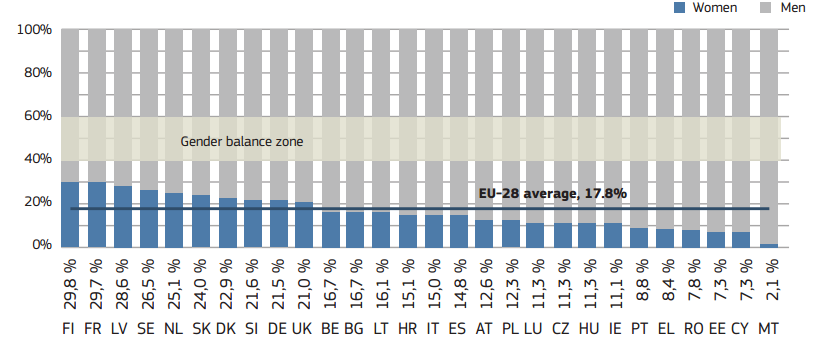Introduction
In many places around the world including Hong Kong, it is observed that women have a higher average educational level than men, however at the decision-making level, we tend to find more men than women. According to the “Standard Chartered Bank Women on Boards Hong Kong 2014 Report”, among 50 of Hong Kong’s leading companies listed on the Hang Seng Index (HSI), only 64 out of 668 directorships were held by women, with a ratio of 9.6%. Is this sexual imbalance caused by a lack of willingness in women to strive upwards; or that when compared with men, women have to overcome a lot more obstacles which has nothing to do with competence?
Gender quotas in the EU
In Europe, similar phenomena could be observed in workplaces. Recent research (October 2013) shows that women directors make up only 17.8% in company boardrooms (see below).

Source: European Commission’s Factsheet on improving the gender balance in company boardrooms: the Commission’s legislative proposal, what changes, and EU progress to date.
To get more women on boards, in 2012 the European Commission proposed legislation which would require listed European enterprises (both public and private) to implement gender quotas. It is hoped that by 2020, at least 40% of non-executive board-members would be women. The proposed bill is as follows:
- If the proportion of female non-executive board-members is less than 40%, the enterprise would have to submit an explanatory report and implement a new selection system so as to ensure fair competition and opportunity for women.
- The new law would not help female candidates “skip the line” as they also have to be qualified. For example, if a man is more qualified than a woman, then the job should be offered to him; only if both male and female candidates show the same qualities, the female candidate would then be favored.
- The new law will apply only in publicly listed companies, with the exception of small and medium enterprises. Subject concerned are only those non-executive board-member positions.
- Once the law is passed, all member states of the European Union have the obligation to carry out relevant measures.
- Gender quota should be regarded only as a temporary measure to achieve better gender equality. It should be valid only till 2028.
The bill passed with a majority in the European Parliament in 2013; now it awaits only the decision of the Council of European Union.
Further reading
- Factsheet on improving the gender balance in company boardrooms: the Commission’s legislative proposal, what changes, and EU progress to date
- Cracking Europe’s Glass Ceiling: European Parliament backs Commission’s Women on Boards proposal
Gender quota in EU member states
Gender quota has already been implemented in France, the Netherlands, Belgium and Spain, while Germany is discussing its implementation. However, some countries are against it as they regard this as government intervention in the market.
Example 1: France (using gender quota)
France introduced gender quota in 2001. The aim is to increase the number of female directors (both executive and non-executive) to 40% by 2018. From its implementation till now, the number of female directors has increased from 12.3% in 2010 to 29.7% in 2013.
Further reading
Example 2: Germany (Considering the implementation of gender quota)
Germany plans to start the policy of gender quota in 2016, with the aim of expanding the proportion of female non-executive board-members to 30%.
Further reading
Example 3: Czech Republic (Against)
In terms of gender equality traditional values still have a strong hold in Czech society, therefore there isn’t much support for gender quota.
Further reading

